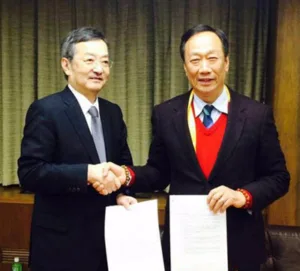
So, Sharp & Foxconn have finally tied the knot.
There is some logic to the deal as Sharp gets access to a vertical customer for its small panel business in particular and Foxconn gets the chance to capture much more of the value of the iPhones that it assembles. It has an opportunity to drive costs down, as it does so well in its businesses, to create a gap between the costs and revenues in the LCD business.
Sharp also has some pretty good IGZO and LTPS technology and has done quite a lot of research work in OLEDs, which look as though they will be more important in a couple of years if you are a supplier to Apple, as Foxconn is. Innolux has been working on OLED for a while, but is behind the leaders. In LCD, IHS’s David Hsieh reckons that on a global capacity basis, with 21%, the combined company is the biggest in the world this year.
However, there are going to be lots of challenges. Sharp and Foxconn have very different cultures and have pursued quite different strategies. When Foxconn took over CMO and merged it into Innolux, there were stories of significant malfunctions during the extended merger, and those companies were both from Taiwan and spoke the same language. The cultural and language issues are going to be substantial this time, not least because this is the first sale of a major Japanese company that was, for many years, the clear leader in a technology, as Sharp was in LCD. On the other hand, it’s possible that Foxconn learnt from the CMO merger.
While most of the talk has, rightly, been about the LCD business, an area of interest for me is what will happen in the “set” business. Sharp has got out of the TV business outside Japan (with UMC, Hisense and Best Buy licensing the brand). It seems unlikely, but a long way from impossible, that Foxconn might want to get back into the branded TV business. Foxconn’s Terry Gou has said that it didn’t want to get into the branded electronic products business, as too few of those involved make a profit.
Because of the problems in the consumer business, almost all of Sharp’s business outside Japan is now in B2B (we reported it was 90% when we went to the big Sharp event a few months ago). Sharp in the US and Europe has a public display business and we reported on it in our ISE report and when the business was reorganised last Autumn, but it’s a relatively small player in the public display business (around 4% market share in 2015 in EMEA).
Now, Foxconn has an investment in InFocus and Michael Kuehn who runs InFocus EMEA is also a director of Foxconn EMEA and Foxconn Cz. InFocus has a developing business in LFDs for collaboration and has made three significant acquisitions in Jupiter Systems, Vidco and Avistar in the last few months. It also has a joint venture with Cima Nanotech in making large touch displays. Terry Gou of Foxconn said, when he bought the original shares in Sakai Display Products (the Sharp G10 fab), that he was not that keen on developing a branded business, but InFocus has been developing, especially in India.
So will Foxconn keep both the Sharp and InFocus brands going? Or might Gou split the products between the collaborative products such as the BigPad which could go over to InFocus, while Sharp is used for digital signage? Will Foxconn still want to license its brand for TV? (when it announced the deal with UMC for Europe in September 2014, it didn’t reveal how long the licensing deal was for, nor for the deal with Best Buy and Hisense in the US). Of course, at the same time as the UMC deal Sharp licensed the brand to Vestel for white goods, an area that a number of electronics companies have moved towards in an attempt to boost profits.
Anyway, it’s clear that this story is a long way from having played out, yet.
Bob

